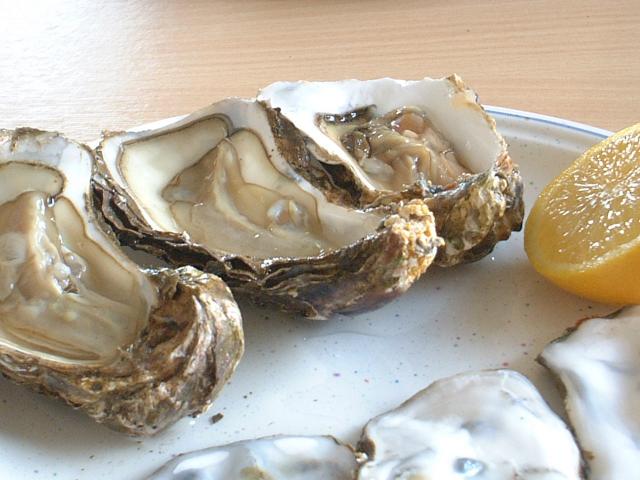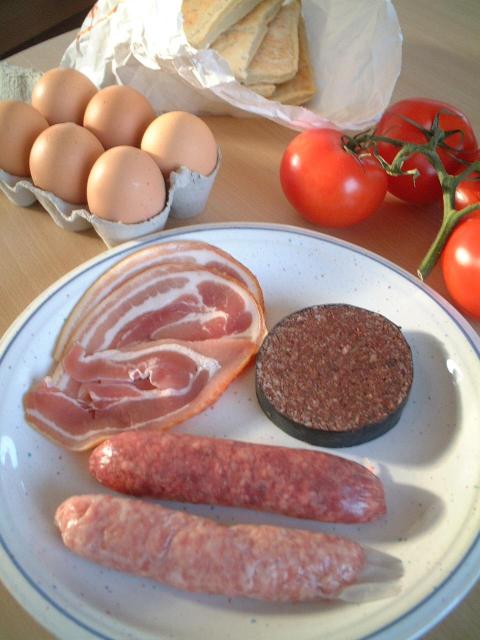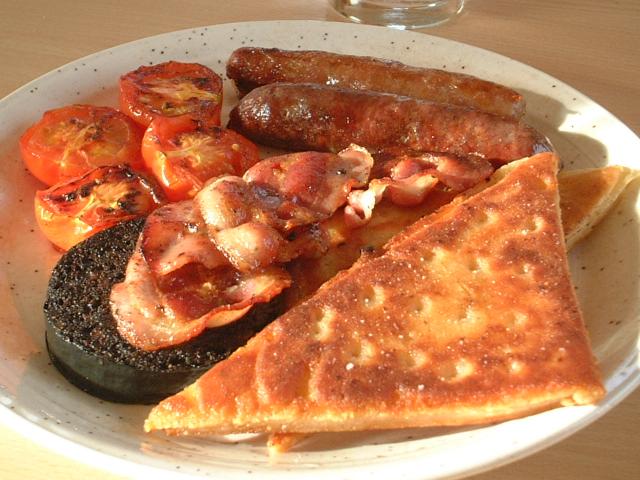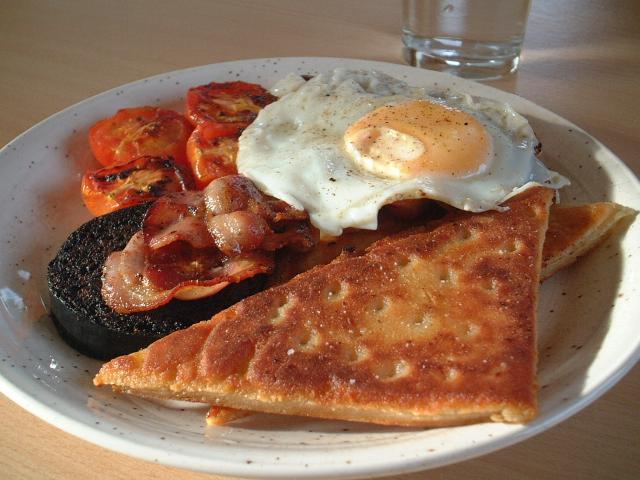-
Posts
1,728 -
Joined
-
Last visited
Content Type
Profiles
Forums
Store
Help Articles
Posts posted by Blether
-
-
... That's the case, at least, with the Christopher Ranch product.
Thanks.
... If I wanted to infuse an oil with garlic, I would heat it hot enough and long enough to kill the anaerobic beasties, and then still refrigerate the oil anyway.Ray
May I ask how you'd do that ? Do you know what's the domestic equivalent of a "12D process" (I know I don't !) ?
-
There's been a certain amount of dicussion in the forums about garlic / herb infusions and the risks of botulism.
From this thread, it seems this garlic is packaged in (air-tight ?) plastic jars. I see vacuum-packed peeled garlic cloves in the markets, too, sometimes.
Steven, do you know if the pre-peeled garlic has been sterilised / treated so that it's also rendered safe for longer-term infusion in oil ? I was wondering about this this morning, as I mixed up another single-serving batch of vinaigrette - another oil-based product with raw garlic immersed in it, albeit minced one way or another.
-
David Goldfarb is quite right about the procedure for making a roux-based sauce.
I've made a lot of roasts in the last year or more - there's plenty to do in that last ten or 15 minutes while the meat rests, with looking after the roast potatoes, preparing veg, warming plates and the rest, and I like to be fast with the gravy.
I'll have the roast itself wrapped in foil, sitting on the carving board. I take 2 or 3 tbsp of fat off the meat roasting tin to a frying pan (if there's enough) and take off excess (if too much remains). To the tin I'll add sufficient liquid (beer, wine, stock, water, a mixture) for the gravy, set this over a burner, stir with a wooden spoon and scrape up the crusted juices. I stop when I've dissolved as much as I can, and when the liquid comes to a boil - that's about the same time. This stays on a holding heat.
The fat in the frying pan (made up with butter or oil if it's insufficient) gets a tbsp or two of flour, then I set it over heat, and stir and fry the roux for a minute or two without colouring. Stirring away at the roux with the wooden spoon in the right hand, I lift the roasting pan and pour all the juices in to the fry pan at once (and dump the roasting pan in the sink so I can grab the frypan handle), stirring all the time till the gravy is smooth. It's a matter of ten seconds or so and I don't get lumps this way.
Lastly, I open the foil surrounding the meat, form one edge into a makeshift pouring V, pour off the juices that the roast has shed, into the gravy, stir and adjust seasoning.
If in the end you don't feel it's rich / glossy enough (doesn't have enough fat), you can always mount the gravy with additional butter.
FWIW, when I learned to make gravy 30-odd years ago, we did it by putting a little flour into the roasting pan with the fat & juices, stirring into the fat over heat, then gradually adding either cold or hot water. I find it easier and more workable doing roux and juices separately. A final point is that it allows a chance at recovery if for any reason the juices in the pan are too burnt - you can stop scraping before it's too late and decant the juices to a saucepan.
-
What did you feel is missing from Wikipedia's 'Japanese Regional Cuisine' ?
It doesn't mention Hamamatsu's pride in its Unagi, which I feel may be a genuine regional food. Too many of Japan's "regional specialties" fall under the category Wikipedia describes as "dishes artificially proclaimed to be regional specialties by local businesses and tourist boards".
-
I stayed at self-catering accomodation on holiday this month. I'd never shucked my own, but bought half a dozen oysters from the fishmonger, who gave a basic explanation of how to shuck them.
The kitchen was well-equipped with tableware, and fairly well with cooking equipment (not so good on knives - I sliced tomatoes with the cheap old bread knife). There was nothing like an oyster-shucker, but on the second morning driving my rental car, an old screwdriver had rolled out on to my feet from under the dash - maybe 8" long, with a well-worn wooden handle and a straight blade maybe 1/8" or 3/16" (4-5mm) wide. Carefully washed, this was my shucker.
I took the "bare hands, hold in one hand and open with the other", approach. I thought it was easy
 It just takes moving the blade tip a little from side to side to find the path of least resistance - wherever the blade goes in deepest. It took moderate pressure to keep the blade engaged while twisting it to open the shell, but never felt like enough that I'd lose control of it.
It just takes moving the blade tip a little from side to side to find the path of least resistance - wherever the blade goes in deepest. It took moderate pressure to keep the blade engaged while twisting it to open the shell, but never felt like enough that I'd lose control of it.I second the comments about being sure to scrub the oysters first to get sand and grit off the outside.
The oysters came from the Kyle of Tongue, just by Scotland's northernmost point. They tasted very like Miyagi bay oysters and were very, very good.

My favourite other improvisation was a disposable foil pie-plate shaped to hold paper coffee filters. And I'm prepared to find that bigger oysters (and thinner-shelled oysters) are more of a challenge

-
A new one on me recently - I noticed egg yolk on the tempura menu at Tsunahachi in Shinjuku. It came out looking like a big, pale, demented spider, but yes, still soft & creamy and they'd gone to the trouble of sourcing eggs with real flavour. Mmm.
I can't pass by deep frying without also mentioning onion pakora / onion bhaji. So easy & so good.
-
I will never again strain the soup stock through a colander that's just sitting in the sink. Because that's not the part I want to save...
-
I should add that the pale sausage is pork, the darker one is venison - made entirely from venison shoulder, no other meat or fat - all the meats are from the local butcher.
-
Hi, Heidi. Those are 'tattie scones' - potato scones. A mixture of mashed potato, flour and butter.
From Meg Cowie's 'Traditional Scottish Food' (Chambers) -
1lb warm mashed potatoes
5oz plain flour
Blend flour into potatoes, adding a little butter if necessary. Roll dough out to 1/4 inch think, cut and griddle for 2 minutes each side.
I've made these myself, and my experience is that with the variation in water content of potatoes, you take the flour measure as a guide. What you aim for is something similar to a bread dough - pliable but leaving the bowl clean. Be fairly generous wth the butter, and of course salt the dough to taste.
Cooked and allowed to cool, tattie scones are a bread-box item and can be eaten cold, spread with butter. As part of a cooked breakfast, they're refried till golden and crisp on the outside. Nothing else tastes quite like them and they are totally addictive :-)
Those in the picture are in fact hand-made scones from the local bakery.
-
A Scottish cooked breakfast, courtesy of Scotland's August early-morning light:



I overcooked that egg. And the whole thing actually happened on Saturday a week ago. Great produce, limited internet.
-
Why must it be fresh yuzu ? Yuzu-koshou (yuzu w black pepper) is a great way to get the genuine yuzu flavour if the pepper isn't an intrusion in the dish or dishes you're planning. It comes in little jars and keeps well.
Yuzu was always a mystery to me - you read up and discover it's called 'citron' in English, but who ever heard of that back in the UK ?
-
I've spent 18 years in Jaspan and the only yaki-ninniku I've come across is in Yakiniku (Korean BBQ) restaurants, where it's peeled cloves of garlic in a thin layer of oil in a foil dish. The dish goes on the grill where you cook your meat and everything else, where it bubbles away for a while. It's ready when you think it's ready, or when it's just nicely cooked. I think the oil may be sesame, but usually I'm concentrating on the MMM, MEAT. Sorry.
This yakininniku may well be a specialty of the chef. My favourite sushi place (now closed, sob !) used to serve yaki-miso - a mixture of miso with finely-chopped negi, a little chili and whatever other magic the master thought was good, used to coat both sides of a flat wooden spoon, then grilled over a flame till golden in places. Very tasty and a great drinks accompaniment, but not something you see on menus very often, if ever. My recommendation for understanding your meaty flavour would be to ask the folks who serve it, if you can :-)
-
I'm not keen on shokupan, but I was passing and I'll make a hit-and-run contribution

I have a National breadmaker. I love it. I particularly wanted to make wholewheat bread because it's so hard to find even in Tokyo, and even when you find it it's only some % wholewheat, not 100%.
I have made a plain white loaf from time to time - the various cycles give various results. These days I like to use the longest, 'fresh yeast' cycle (even though I use dry instant yeast), because longer raising times give the best flavour development. My favourite breadmaker product is a pizza dough (a bit wetter than a normal bread dough), which I take out after the 'pizza dough' cycle and then let develop for 4 hours at room temperature (the recipe book says 'use right away'). It makes superb pizza (with careful handling involving a lot of flour) and wonderful, light-as-a-feather, open, tasty French-style bread that you have to eat within a day to have it at its best.
For a breadmaker loaf, I find I can pretty much substitute wholewheat flour for white bread flour, weight for weight, in any percentage, and do so depending on my mood. The traditional rule of thumb for a bread dough is '2/3 hydration' (eg 500g flour with 333ml water) - the experts in the bread-baking sections of eGullet can tell you more about that.
Ironically I use the machine for convenience, but discovered I prefer a no-knead 100% wholewheat loaf when I can be bothered with lining loaf tins with paper, and washing an enormous mixing bowl.
Wholewheat flour can be had in many Tokyo supermarkets, but for prices like JPY400-800 per kilo. Shikisai ('four seasons') in Hokkaido sell 5kg packs from their web shop, as well as 5kg packs of strong ('Haruyutaka') and semi-strong ('Minorinooka') white bread flour from their web shop. If you order the optimum quantity at once, it works out, for example, just under JPY220/kg for wholewheat flour. You need written Japanese to buy from them.
-
So to make up for it, another one for you Americans -
Jumped Shark
- Southern delicacy, past its best
-
My sister and I have a word for the slimy food bits that need to be transported from sink trap to garbage at the end of cleanup: clart.
Clart or Clort is a Scottish dialect word for muck. More usually found in its adjectival form - "dinnae come in here in those clorty boots !"
Dreich is another Scottish word I love - wet, damp, foggy, grey, miserable. "It's guy dreich" - 'Guy' pronounced like 'guy' as in bloke, but with the 'igh' sound of 'mighty', and meaning 'very'. Maybe Seattle-ites can relate ?
(Sorry, off-topic, and I didn't even make them up).
-
It's soup time around these parts, and I want to try my hand at leek and potato soup!
Just use your normal supermarket negi. You can leave out the coarse leaf tops if it bugs you - I started out being that fussy, but these days I just use the whole thing.
With due respect to Helen, I find they soften up fine, gently sweated in oil for 10 or 15 minutes before I bung in the stock & spuds.
-
My parents are Latvian so I grew up eating dark rye bread.
I fins Japanese bread, even the so-called "good stuff" is just too spongy and airy and lacking in any body or texture. That seems to be a recurring theme in Japanese food though.
Yeah, 'fuwa-fuwa' (light & fluffy) is frighteningly popular, isn't it ?
Back home I'd only eat wholewheat bread. The best bought-in experience I've had here in Tokyo was when I was working in Ark Hills, where there's a branch of the 'Aux Bacchanales' (oo baka naru ?) French bistro/bakery. I persuaded them to bake one of their square loaf tins (they do bake 100% wholewheat in a half-ball shape as part of their regular range) of 100% wholewheat at a time for me. That made three loaves a bit bigger than the standard Japanese 'ikkin' size, and they did a great job at a very good price.
Now those days are gone I'm not so self-assured, err, I mean I mostly bake my own using 100% wholewheat from these guys Sikisai and the no-knead technique Delia Smith re-popularised in the UK, based on Doris Grant's war-time method. It goes: warm the flour, mix the dough, shape, allow to rise for an hour or so, bake.
Prasantrin, I agree we have lots to celebrate in the way of bread in non-rural Japan. Fluffy white plastic CBP bread doesn't do much for me, but some of the bakeries do great stuff. Even on the mass-produced generic supermarket front, there are Pasco's whole grain English muffins at JPY137 (recently ~JPY150 ?) for four. Yay !
-
... "Nikibi no Kashi" (Zit Confectionery).

SAF yeast is also avaiable at Cook-Y クックY, in the 500g pack for under a thousand yen, that makes the little box of one-use sachets that you see more often look rather forlorn.
Also good for coffee beans, frozen stuff and a range of amaze-the-unwary traditional Japanese kitchen equipment.
-
I'm not quite sure if this question fits in this thread but I'd like a translation of manjo and hinode. Both relating to mirin. Cheers
Well... Cutty Sark is a brand of whisky, and that means 'short skirt' or 'short dress'. 'Famous Grouse' is another, and a grouse is a particlar kind of bird.
Hinode means sunrise. Manjo - maybe 'good woman' ? I don't know this brand. What are the characters ?
-
... getting the onions to a really dark brown for a curry base without burning the onions in parts or the spices...
For the same application, I choose a wide-but-deep 12" copper-base stainless stew pot. I was tired of (a) onions slipping out of the frying pan when I stirred; (b) never having enough room in the pan to finish the dish - and it was one big frying pan, and © having spots of oil all over the stovetop and surroundings after twenty minutes of onion frying. A stew pot fits in the oven, too.
Are you using enough oil ? (I'll note her that I used 1.5 cups of oil to 6 of chopped onions yesterday). With respect, I'd qualify andiesenji's comment and say you can fry your curry onions really quite deeply piled up and still get them brown.
As for saute pans, I never understood the attraction till I got one - reluctantly - as part of a set that had other stuff I wanted. Now I love it - there's more base area to a 12" saute pan than there is to a 12" frying pan, and much more room for completing a dish.
-
184. sushi, including 'masago' and 'amachi'
CLUE: in a separate scene, Noodles eaten from a paper carton (on a park bench)
Lost in Translation?
Sorry, Viva, no, not Lost in Translation. Another clue: in another scene, Snapper - discussed but not seen.
-
Hi, Dave. Kudos to you for being thorough and precise. Seriously. That's cool !
Mind you, step 8 ? 330-37 = 293 already. Sheesh. Is calculating that much fun ?

May I ask an ignoramus's question about pink salt ? If I, say, go and pick up some of the 'pink salt' that I think is from India and has become a fashion in Tokyo over the last few years, will I have something with 6.25% nitrite ? What is the particular 'pink salt' you mean ?
For clarity, I believe one of the main points about nitrate/nitrite is it keeps the meat red-pink, rather than brown-grey. I was never bothered enough (I figure it's like dyeing kippers). I've been happy with my bacon - what am I missing by not bothering with them ?
-
184. sushi, including 'masago' and 'amachi'
Additional clue - in a separate scene, Noodles eaten from a paper carton (on a park bench)
-
Chris - did you fry up a sliver of meat to taste for salt ? I'm assuming you know you can adjust the salt level if necessary, by soaking in fresh water.



Peeled Garlic
in Kitchen Consumer
Posted · Edited by Blether (log)
Thanks for the link, Ray, that's very informative. When I asked the question I was also trying to recall where I read dougal's summary of the relevant temperatures, which I've since found again, here. In the same thread andiesenji made a persuasive argument for an hour in a 275F oven.
I guess there's no easy process that's going to leave raw-flavoured garlic suitable for keeping in oil for a long time.
Thanks too for your crockpot method. For myself, it looks like I'll be staying with make-and-use fresh in small quantities. Here in Tokyo I can get a string bag with about 20 heads of good-quality Chinese garlic for a couple of bucks (it costs twice as much for three heads of domestic garlic in a string bag). Every time I have to throw out excess garlic I wonder once again where I saw that recipe for soup "aux quarantes wotsits d'ail".